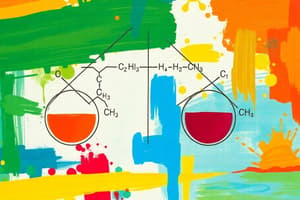Podcast
Questions and Answers
What does balancing a chemical equation ensure?
What does balancing a chemical equation ensure?
- The coefficients will always be equal
- The number of atoms for each element is the same on both sides (correct)
- The reactants are transformed into new elements
- The products can be created from different substances
What is the law of conservation of mass?
What is the law of conservation of mass?
- Mass can be destroyed in isolated systems
- Mass can be created in chemical reactions
- Matter is transformed into energy during reactions
- The mass of reactants equals the mass of products (correct)
Which part of a chemical equation indicates the substance formation?
Which part of a chemical equation indicates the substance formation?
- Arrow
- Coefficients
- Products (correct)
- Reactants
What do coefficients in a chemical equation represent?
What do coefficients in a chemical equation represent?
What does a subscript in a chemical formula signify?
What does a subscript in a chemical formula signify?
Why is it essential to balance chemical equations?
Why is it essential to balance chemical equations?
What does the arrow (→) in a chemical equation represent?
What does the arrow (→) in a chemical equation represent?
What happens if a chemical equation is not balanced?
What happens if a chemical equation is not balanced?
What are reactants in a chemical equation?
What are reactants in a chemical equation?
What is indicated by the phrase 'symbolic representation of a chemical reaction'?
What is indicated by the phrase 'symbolic representation of a chemical reaction'?
What is the primary purpose of balancing a chemical equation?
What is the primary purpose of balancing a chemical equation?
In the equation H2 + O2 → H2O, how many oxygen atoms are present on the reactants' side?
In the equation H2 + O2 → H2O, how many oxygen atoms are present on the reactants' side?
When balancing the equation C3H8 + O2 → CO2 + H2O, which element is typically balanced first?
When balancing the equation C3H8 + O2 → CO2 + H2O, which element is typically balanced first?
After balancing the equation C3H8 + 5O2 → 3CO2 + 4H2O, how many oxygen atoms are present in the products?
After balancing the equation C3H8 + 5O2 → 3CO2 + 4H2O, how many oxygen atoms are present in the products?
What is the balanced equation for the combustion of methane?
What is the balanced equation for the combustion of methane?
In the formation of ammonia, what is the unbalanced equation?
In the formation of ammonia, what is the unbalanced equation?
What does doubling the coefficient of a reactant indicate in a balanced equation?
What does doubling the coefficient of a reactant indicate in a balanced equation?
After balancing N2 + 3H2 → 2NH3, how many hydrogen atoms are present in the reactants?
After balancing N2 + 3H2 → 2NH3, how many hydrogen atoms are present in the reactants?
Why must coefficients be simplified in a balanced equation?
Why must coefficients be simplified in a balanced equation?
Study Notes
Balancing Chemical Equations
- Balancing Chemical Equations: Ensures atoms of each element are the same on both sides of a chemical equation, reflecting the law of conservation of mass.
- Law of Conservation of Mass: Matter cannot be created or destroyed in an isolated system. The mass of reactants must equal the mass of products in a chemical reaction.
- Components of a Chemical Equation:
- Reactants: Starting materials on the left side of the equation.
- Products: Substances formed by the reaction on the right side of the equation.
- Arrow (→): Separates reactants from products, indicating the direction of the reaction (reactants yield products).
- Coefficients: Numbers before formulas indicating the number of molecules or moles of each substance.
- Subscripts: Small numbers within formulas representing the number of atoms of each element in a molecule.
Balancing Chemical Equations Step-by-Step
- Step 1: Write the unbalanced equation with correct formulas for reactants and products.
- Step 2: Count the atoms of each element on both sides of the equation.
- Step 3: Adjust coefficients to balance the number of atoms for each element, starting with elements appearing in only one reactant and one product.
- Step 4: Double-check the balance by recounting atoms to ensure they are equal on both sides.
- Step 5: Simplify coefficients if possible (divide by common factor).
Examples
- Combustion of Methane:
- Unbalanced equation: CH4 + O2 → CO2 + H2O
- Balanced equation: CH4 + 2O2 → CO2 + 2H2O
- Formation of Ammonia:
- Unbalanced equation: N2 + H2 → NH3
- Balanced equation: N2 + 3H2 → 2NH3
Studying That Suits You
Use AI to generate personalized quizzes and flashcards to suit your learning preferences.
Description
Test your understanding of balancing chemical equations with this informative quiz. Explore the law of conservation of mass, the components of chemical equations, and the importance of coefficients and subscripts in chemical reactions. Perfect for students studying chemistry!




